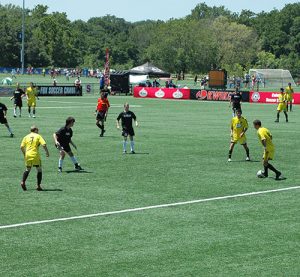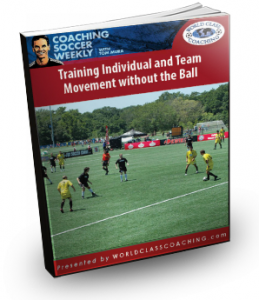Podcast: Play in new window | Download
Subscribe: Apple Podcasts | RSS
 We’re starting to wrap up our Futsal season. I’m continuing to work on technical skills that will help the players in Futsal but I’m starting to plan for the transition back to outdoor. I’ll talk about that more in the coming weeks.
We’re starting to wrap up our Futsal season. I’m continuing to work on technical skills that will help the players in Futsal but I’m starting to plan for the transition back to outdoor. I’ll talk about that more in the coming weeks.
We wrapped up a three week MicroCycle where we did a progression of fast footwork and change of direction moves.
This last week we did mostly 1 v 1 between two dots. The dribbler tries to fake the defender and get to one of the two dots before they do. If they do, they get one point. After 30 seconds the players change roles. The player with the most points after they’ve both attacked wins the round.
There’s a ‘ladder’ setup where the winner moves forward and the loser moves back. The players love it because it’s competitive and I love it because they get to use the fast footwork skills under pressure.
 This week’s question comes from Sammy Grantham. Sammy is a longtime listener and I interviewed him back on episode 102 about Differentiated Coaching.
This week’s question comes from Sammy Grantham. Sammy is a longtime listener and I interviewed him back on episode 102 about Differentiated Coaching.
Sammy says,
“There was a podcast you did a year or two ago and you were discussing different types of training sessions. You mentioned the whole-part-whole method. It was briefly discussed in a coaching course I took a couple of years ago, but it almost seemed like the instructor hit on the topic because it was part of the course curriculum and moved on. There wasn’t a lot of detail.
I have a cursory idea of what it is. I’ve done some googling and amazingly little. I was wondering, is the whole-part-whole method something you use much? If so, could you give some examples of sessions you’ve ran.”
Thanks for the question Sammy!
It’s my understanding that the Whole-Part-Whole method is going to be used in the new Grassroots Pathway courses. They’re calling it Play-Practice-Play.
I’ve been asked to be a Coach Educator for the new courses so I’ll let you know more about the curriculum in the future.
I told Sammy that, I use it more in the spring than the fall because I can use it to see what I topics I need to return to.
An example would be playing a four-goal small-sided game and see how the players perform. If they fail to recognize the opportunities to switch the ball because they are facing the ball and not opening up and looking away from the ball then I would do an activity to work on this area. I’d use something like a diamond passing drill to work on opening up and then a possession game where team keeps the ball in one area and then switches it after a certain number of passes or certain amount of time. Then I’d return to the four goal game or similar game to see how the players perform.
In This Episode
This week I want to revisit Episode 14 Do Your Players Move Without the Ball? I think it covers an important topic in a way that makes it easy for even young players to learn how to move to receive the ball.
Printable Show Notes
The show notes for each episode are accessed through the WCC Training Center.
They are FREE but you will need at least a Free Membership to the Training Center in order to view and print them. They’ll be available there for eight weeks before they’re placed in our archive which can be accessed at any time by Elite Members.
Click on the image of the notes and if you’re already logged in to the Training Center you’ll be taken to the Podcast page. If you’re not logged in your be taken to a login page where you’ll also be able to login or register if you are not already a Member.
Remember!
Make sure you subscribe to Coaching Soccer Weekly through iTunes, or your podcast provider of choice, to be sure you never miss an episode.
We would appreciate it if you would leave us a 5 star rating and/or a written review on iTunes to help spread the word about the show and ensure that we can continue to bring you top notch guests in the future.
Future Episodes
Next week I’ll look at is and isn’t acceptable sideline behavior for a coach.


I am loving these podcasts, Tom. Thanks for doing them. You’re helping me become a better coach.
Cheers,
Brandon
You’re welcome Brandon. I’m glad you find them useful.
Tom
How do you handle scheduling multiple teams as a coach? Specifically, games on the weekend as well as black out dates and tournaments? Coaching more than two teams can be difficult when it comes to playing tournaments as well as league. Do you have a formula that you use in your own club?
Jason,
Our leagues are very accommodating when it comes to coaches with multiple teams. We are allowed to submit three weekends as, “No Play” weekends for tournaments and other conflicts. They do a great job of making sure we don’t have overlaps between our games on the weekend. Our local tournaments take the same kind of care in their scheduling. When I travel out of town with more than one team I always communicate with the tournament director in advance to make sure they are able to guarantee that I won’t have conflicts with roundplay games. The finals can be an issue if there’s a conflict but our other coaches in the club are helpful in these situations.
Thanks Tom! I like how you give players concepts to start with and then allow them to develop their own interpretation and creativity.
The 3 base runs are a good starting point for movement. Also, I like how you start off teaching the first run and then progress to the next run once they’ve got it figured out.
This spring our U-12 boys are really starting to “get” the movement we want from them and it’s made a big difference in how they play. I remember getting frustrated trying to teach them this movement just a few years back. The timing always seemed to be a big part of the problem. They might go through the motions at training but grasping the timing of the movement was a challenge.
At what age do you start teaching players the three runs and how to time their movement?
Thanks!
Thanks Ben.
I start teaching the ideas of timing as we work on opening up for a pass. That can be done starting at U9. I don’t work on the different runs as described until U11.
Great, thanks Tom! Definitely going to use the concept of the 3 base runs.